
 See also:
See also:

 "Hempen Culture in Japan",
Hemp Library,
taima.org main index
"Hempen Culture in Japan",
Hemp Library,
taima.org main index
HEMPEN CULTURE IN JAPAN (continued)
Previous chapter:

 Hemp in the Japanese language
Hemp in the Japanese language
The Japanese strains of hemp
According to a USDA comparison studies, Japan's strains of hemp
certainly were tall and big, beating out European and Chinese strains.
1912 ". . . Japanese Hemp is beginning to be cultivated, particularly in
California, where it reaches a height of 15 feet. Russian and Italian
seed have been experimented with, but the former produces a short stalk,
while the latter only grows to a medium height." (Dewey, Dodge)
The USDA continued experimenting with Japanese strains with remarkable
success. Growing in Virginia, a strain from Tochigi-prefecture even
broke their height record.
1920: "The three best strains, Kymington, Chington and Tochimington
[named after Tochigi prefecture in Japan] averaged, respectively, 14
feet 11 inches, 15 feet 5 inches, and 15 feet 9 inches, while the
tallest individual plant was 19 feet. The improvement by selection is
shown not alone in increased height but also in longer internodes,
yielding fiber of better quality and increased quantity." (Dewey, Dodge)
A clear estimate of how well these strains grew in their native soils
under the care of talented Japanese gardeners is difficult to arrive at.
Due to this, any definitive research on Japan's crop volume was
destroyed in WW2 fire storms along with most government records.
(Atomic Bomb Museum).
Hemp in the Rural Areas
Miasa-mura (beautiful hemp village) is located amongst the foothills and
valleys in the shadow of the Japan's Northern Alps in Nagano-prefecture
(north central Honshu, the largest island.) It is one former center of
cultivation.
When asked how much hemp used to grow in this region one farmer
responded by saying, "Do you see these rice fields?" pointing to the
vast checkerboard of rice fields we'd been cutting and bundling, "before
the war, we didn't grow rice here, we grew hemp."(Kondo)
In 1998, this area will host the Winter Olympic Games and perhaps this
hemp heritage will receive some global exposure. Miasa town's brochure
features the distinctive seven serrated edge hemp leaf. The town
educates visitors with a hemp and flax museum and spinning equipment on
display. (Personal Records)
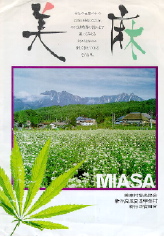
(click to see big picture)
Many residents in the town are anxious to resume legal hemp cultivation and are frustrated by the long and always unsuccessful application process required. However, a variety of hardy strains of free-growing hemp continue to abound in the quickly shrinking back-country. Most of this is wild but some is cultivated for use by farmers continuing on the old ways.(Inoue)
In this area of Nagano-prefecture, the local government administers the growth of one or two closely monitored hemp fields of exactly one
thousand plants grown at a different location in rotating villages
(Miasa, Ogawa, Shinshushimachi, Omachi, Nakajo) in the gun (county)
every year. The local authorities count the plants at the beginning,
during and end of the growing season to ensure that no hemp has been
taken. The hemp fiber isn't used at all, in fact, after the plants
mature and bear seeds, the seeds are harvested to maintain a fresh seed
stock in the town coffers and the hemp crop is burned completely in the
field. (Gruett)
Certainly a waste of seed but at least the acclimated strains aren't
extinct as has happened in other countries.
In that same area, an American expatriate farmer and craftsman has
stepped back a few hundred years and "reopened" a village. The hamlet of
Gonda was founded about 600 years ago by monks who stayed on when they
found a clear water spring in this secluded mountain valley. The area
thrived as a farming community for several families, probably mostly
unaware of the changes occurring in their nation which was far away as
the several day long hike to the village to trade for salt.
As Japan entered into foreign wars and skirmishes, young people were
drafted from the farms to fight for the Emperor, and many never
returned.
This migration went on and off for close to 50 years with wars all
around the Pacific and Asia. In the post-war poverty, poor country people
migrated to the cities to seek work where many were exploited into
deplorable working conditions as a nation rebuilt chasing the
strengthening Yen. Any people left in the villages, split to the city
when the economic boom began.
Most fled the rural life except for the oldest child of each family who
must remain to carry on the family traditions, maintain the graves, tend
the elders and run the house. A household bursting with long-living
elderly and scant few workers.
By early 1970's, Gonda was still half a century behind, no utilities,
roads or services. A village with just old folks remained and the city
officials removed them into city condos rather than provide
infrastructure and services. For a decade the area stood vacant, silent,
fading back into the hills except for an occasional relative, bringing
ceramic saucers of sake and oranges to the graves. Retired from the
Navy, Steve and his family resettled the village and homesteaded there,
tending to the area and again using the bounty of the mountains. With
hard work and smartly planned organic agriculture, Gonda's fields once
again bloom with life. In their valley, there are discovering the rich
agriculture history of the area.

When first arriving to the region in the early 1980's, Steve saw film
footage from about 1970 of farm grandmothers hand-harvesting & retting
hemp. The film showed the Grandmas pulling the long, fiber strands from
hemp plants and shaking the seeds into woven baskets. The film was
presented by a local school teacher in a town meeting to discuss the old
ways. Old ways that are now illegal. Still in the forests and hillsides,
wild and tended hemp continues to grow. (Gruett)
The Emporer's Hemp Clothes
On Shikoku (the smallest of the four main islands) hemp is grown for the use of the Imperial family.
When Emperor Hirohito passed on in 1989, a coronation was held for the heir. The Emperor himself is regarded as a direct descendant of these Gods and acts as a sort of high priest in this pagan Shinto belief.
Since Hirohito's son was also becoming the "living entity of God",
there was to be a special Shinto ritual. In Shinto, as hemp is the
symbol of purity, the new Emperor certainly had to wear hemp garments
which had become unavailable over the course of his father's long rule.
A group of Shinto farmers in Tokushima-ken had thought ahead and planted a symbolic yet subversive crop and presented the Emperor with his new clothes made of pure local hemp. (Gruett) (Bennet)
They are still producing this hemp crop for the exclusive use of the
Imperial family.
Further, hemp is being grown somewhere in Nagano-prefecture for making
the bell ropes, curtains and other essential goods for Shinto and Buddhist
houses of worship. (KTO, Maeda)
In this area, the hemp tradition lives on in festivals and dance. The
Japan National Tourist Organization tells about this in their on-line
brouchure of the area:
"Oasahiko Shrine: Just walking to this quiet shrine is a lovely
experience. On either side of the road are 400- to 500-year-old black
pines designated a Prefectural Natural Monument. Several wonderful
festivals are held here: shrine dances (kagura) by shrine maidens on
lunar March 2 to pray for abundant crops, a lion dance (shishi mai) in
November to honor the god who brought hemp and cotton to the province;
and at the lunar New Year kimono-shaped paper cutouts (hitogata) that
are procured at the shrine office are floated down the shrine's crystal
stream in a symbolic exorcism. "
Cloth, Paper and the Arts
Cannabis sativa L. is also a ingredient in making washi (finely-made
papers). (AJHWA)
These traditions are confirmed by a modern, commercial paper corporation:
"A.D. 105 - Paper as we know it was invented by Ts'ai Lun, a Chinese
court official. It is believed that Ts'ai mixed mulberry bark, hemp, and
rags with water, mashed it into a pulp, pressed out the liquid and hung
the thin mat to dry in the sun. Paper was born and this humble mixture
would set off one of mankind's greatest communication revolutions.
Literature and the arts flourished in China.
A.D. 610 - Buddhist monks gradually spread the art to Japan. Papermaking
became an essential part of Japanese culture and was used for writing
material, fans, garments, dolls, and as an important component of
houses. The Japanese were also the first to use the technique of block
printing. " (Mead)
Folks are still able to buy hemp clothing and household
accessories that come from mostly China, Korea and now the US and
Canada. Hemp and its breezy feel is particularly favored as summer
apparel in the muggy heat. The domestic Japanese hemp is especially
finely woven and some weave have a sheer, crepe quality is unlike
anything else in the world.
Portland, Oregon dye-master, Cheryl Kolander has several exceptional pieces featuring subtle patterns and the finest denier weave of any hemp available.
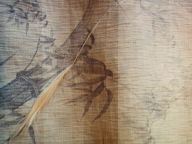 
Often dyed in fermented ai (indigo) vats, the fine, almost sheer weaves show the possibilities and versatility of hemp. Weaves so fine that the fibers looks more like raw silk or flax. Certainly, Japan's experience with silk complemented the spinning and weaving of such fine denier thread into a more usable fabric than the silkworms'. (Kolander)
Occasionally, some domestic makes it to the market place where is sold by international high-end silk fabric dealers in obviously very small
quantity. Amounts, suitable only for collecting and research and not as
a commercial venture of consequence. (Kolander)
Kyoto has always been the center of art, humanity and spirit of Japan and because of some well-timed encouragement from a US Diplomat, Kyoto was not significantly bombed in WW2. (Atomic Bomb Museum) Thus the traditional textile arts carried on in the Old Capital.
Artists here still continue to use hemp cloth for making sheer woven
cloth, hand dyed curtains and screens, paintings and quilts.
These arts often specifically require hemp cloth as it works best with
the natural dyes and wax resist methods of design. (Tomoaki) Obtaining
true hemp is difficult and the replacements simply do not perform as
well in the field or in the studio.
The same artist who owns the piece of ancient hemp paper comments on how he obtains his stock: "I am very strict in my selection of paper because they are so vital to my work. Each artist must select his paper according to his own tate. Because I am well-know, I have no difficulty obtaining good papers, fortunately. Like most Nihonga (Japanese as opposed to Western technique) artists, I use mashi (hemp paper) There are many kinds of mashi even today, differing in character depending on where it was made. It is possible to find huge sheets of it."
A common pattern in fabric is the traditional asa no ha (hemp leaf),
where the seven blades of the leaf intersect forming a mandala like
pattern. This pattern is often seen in curtains, quilts and kimono.
(Yasuko) (Personal Collection)


This pattern is commonly seen in painting depicting the "floating world" of Geisha. The colorful art prints of the day often depict
the subject's kimono with this geometric leaf pattern
(personal collection) as well as relaxing and smoking a long slender pipe while between customers. Another interesting artifact from that world is a hair comb detailed with hemp and perhaps Japanese maple leaves. (JW)

In 1929, one of the most celebrated paintings of it's time, Shimizu's
Taima Shukaku (Hemp Harvest) depicts farmers cutting down thick, dense
hemp fields, surrounded by a vibrant valley. (Marui) This painting was a finalist for a kind of national "painting of the year" award from the government.

Wood cuts prints from a artistic agriculture grow book from 1979 show the same dense fields. The caption explain how one must walk through the fields to "ventilate" the plants. Other captions explain various,
well-evolved processes including three step water retting technique and
explain a means of bleaching by making alkaline chemicals like potash
and caustic lime. (JW)
Food and Medicine
In contemporary Japan, ground hemp seed remains in the diet in Shichimi (seven spices) used for flavoring Udon noodles. Unsterilized hemp seed bird food is readily available too.
While soy and rice have long been the nutritional staples, hemp seed was part of the diet, used mostly as addition to mountain vegetables or else as gruel.
However, when the armies of the fuedal age went to war , they often subsisted on balls of ground hemp seed and brown rice gluten to keep them strong.
In recent times, even brown rice has virtually disappeared from the storehouse in favor of processed foods and foreign dishes. Certainly, Japan's skill in soy foods like tofu and miso will adapt well into hemp which shares so many of the health benefits.
The national government continues to maintain its own private stash of seed and plants for posterity and experimentation.
Since 1946, when hemp cannabis was in short supply due to the war, the Tokyo Metropolitan Government Medicinal Plant Garden has maintained a seed stock and bred varieties of asa for research at a large, secure
complex in suburban Tokyo. Given the Japanese knack for detail and
research, it is certainly a valuable cache of information and genetics.
The director, Torao Shimizu, maintains the plants are just to teach
people what hemp looks like so they can dispose of it should it be found
it growing in their area. (Lazarus, JW)
While the original intent of the compound seems to have been to advance
medicinal use of cannabis, this motive has
been lost under a cloud of paranoia though the use of seeds for medicine is common information as mentioned in Kojien, Japan's major encyclopedia:
"The seeds are used as bird seed and can also be used as a medicine
(asashijingan) as a mild laxative. " (Koijen, JW)
Contemporary Products and Entreprenuership
Household accessories like washcloths, curtains continue to be sold,
made from Chinese and Korean hemp. More recently, new hemp products from western hemp manufacturers are taking off. Given Japan's enthusiasm for traditional, rugged North American fashion, this will be a burgeoning industry should the restrictions relax.
There are now several stores carrying hemp products including Earth Shop run by American ex-pat Neil Hartman on the island of Hokkaido.
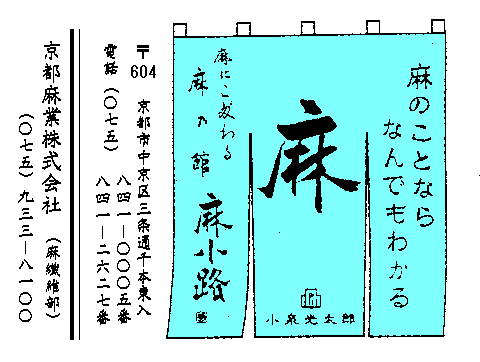
In Kyoto, a traditional hemp shop, Asakoji,
continues to serve patrons since the 1600's, surviving wars and prohibition. Perhaps more
importantly, the store emphasizes the age-old connection of spirituality, art and agriculture the Japanese community
a vital example of hemp in Japan. Their hemp noren sign boasts in Japanese "We only know about hemp but we know every detail." (Asakoji's sign)
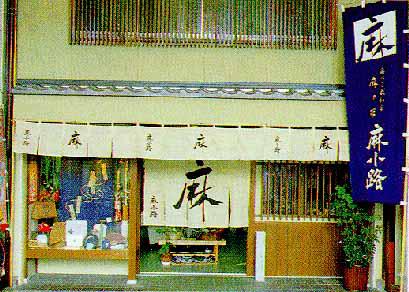
At Taimado (hemp shrine) in Tokyo, a hemp shop sells mostly imported hemp goods and is a center for activism and research. Citizens are increasingly using political means, as well as spiritual, to restore hemp cultivation in their homeland by distribution of information and products.
As more international exchange takes place, cross germination of new ideas in business and activism occurs. This is bound to increase the markets in both countries. With resources like WWW making borders and time zones irrelevant and young Japanese entrepreneurs looking to expand into an exciting field, some American companies are beginning to reap the rewards from this vast potential.
Changing the Laws
Like other governments, the Japanese parliament continue to be hesitant and under-informed about the benefits of extensive cultivation. The actual current legal status still leaves opportunity for application to
cultivate hemp.
This is a frustrating lengthy, futile process as the government rarely issues permits. It has been so long that most civil servants respond
simply with a blank look. (Gruett)
For the first two decades, the law seemed to exist only on the books.
Farmers still grew hemp for community uses and the law was not enforced
until the outside pressures of "Internationalization," caught up.
"Internationalization" is the closest translation of Japan's approach
and attitude towards making a niche as a responsible, major world
player. Continued American military and business occupation, coupled with
internal government scandals and instability, made creating a
international identity on it's own terms difficult for Japan.
The Hemp Control Act was first enforced in the harvest of 1967 when 20 stalks were seized from a farmer's collective in the Shinshu, Nagano region. (Yamada) The ensuing legal proceedings sparked the hemp
liberation movement in Japan.
In the early 1970s, the first modern hemp symposium was held at Kyoto University and a court challenge was filed to argue that the ban was
unconstitutional. The hemp movement became a struggle not only against
hemp laws but against the pressing thumb of United States influence and
the continuing occupation of Okinawa by military forces.
Hemp conferences are now attended by a diverse group of lawyers,
doctors, students, and farmers who are lobbying the government and
encouraging research.
In Iwate prefecture, an association of hemp farmers promotes a festival in which they invite the public to join in the harvest.. According to Haruko Oda, "we get more and more people evry year who come to join in the harvest . . We cut the seven-foot high plants, blanch them in hot water and then burn the leftovers." (Young)
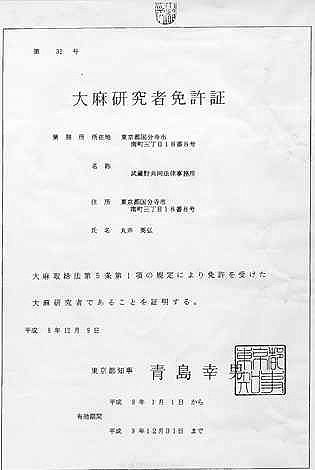
A Shizuoka lawyer who owns a coveted permit to cultivate cannabis for personal research has been representing marijuana arestees for much of his 20+ year career. He and his colleagues are also blitzing the mass media, publishing research and dissertations in popular magazines to encourage public education about hemp and its potential products. Hemp's potential as a building material is especially intriguing to this group who plan to construct hemp houses throughout their country, reducing Japan's massive importation of wood as well as showing a useful application of hemp.
(Marui)
Before 2000, Marui's group plans to call the Taima Torishima Ho (Hemp Control Act) for review to test its constitutionality. (Marui)
If hemp is given fair time, this will have a resounding impact on this
island nation and will certainly call the Japanese nation to debate at
many levels.
Even some government workers are owning up to Hemp's heritage, as a Health and Welfare spokesperson points out, "In the first half of the century, cannabis was a prescription drug for treating asthma and other respiratory diseases, but Japan was forced to adopt stricter controls due to international pressure. This means that under Japanese law, cannabis is treated as if it was as dangerous as heroin or cocaine . . . although it could be said that cannabis is as addictive or mind-altering as alcohol." (Young)
The Shizuoka Police Department has this to say about the mind-altering effects of cannabis,
"The user may feel refreshed or have a sense of extreme well-being and become very talkative. It affects all five senses and distosrts the normal sense of time and distance. It also affects perception, judgemnt and thinking. Habitual users of cannabis suffer from illusion or hallucinations. Sometimes they loose control to the point of violence or provocation."
For these reasons, the police are made to crack down on marijuana users witht he same zeal as they go after the Yakuza (organized crime families) who import and distribute Methamphetimine which is the most popular illegal drug in Japan.
Current Agricultural & Economic Issues
In a country of political indifference, the agricultural Co-op have been a vocal, organized political force since the fuedal period. Increased,
low-cost crop imports, reductions in subsidies and difficult weather
have made many farmers look for a change from growing rice year after
year. This has also led to a reemergence of sustainable, organic farming
techniques that will speed the implementation of industrial hemp
cultivation and rejuvenate the tired soil.
At several universities around Japan, research and test cultivation of low-THC hemp has occurred since the early 1990's. In Tochigi prefecture, a group has recently begun producing and marketing rugged, refined paper made from pure, domestic hemp. This handsome paper is available in limited supply and is being used for printing cards and book-covers. Shinshu University in Nagano is also cultivating but information is not widely published. Various projects are underway in Iwate and Fukui prefectures and on Hokkaido, showing hemp's potential in many latitudes
and climates.
In 1997 at least two permits have been granted to individual growers for crops in Shizuoka prefecture, much closer to the
urban center of Japan. One permit went to a young farmer named Yasunao Nakayama who says, "I can hemp to make fibers and extract the oil Hemp and cannabis were used throughout the ages in Japan for clothes and as an herbal remedy. I'm just continuing that."
The other permit to the lawyer Marui for personal research due his persistant legal efforts.
Whether Japan will go the hempen path a kin to trading partners such as Australia, New Zealand, Thailand and Canada remains to be seen.
The US continues to operate military bases and maneuvers in Japan at the citizens financial and emotional expense. Heinous crimes and
environmental filthiness makes this is a subject that is more
infuriating to the populous in the 1990's than ever before. While under
the protection of the Americans, Japan cannot exercise true sovereignty
in making these vital decisions.
As the threat in Southeast Asia settles, perhaps Japan will reaffirm its place as a regional leader and embark on a hemp cultivation program that will be a model for other Asian nations, just as Japan's economic growth provided an example, an example that many other Asian island nations are now emulating with staggering success.
Japan is 80% forested much of that is in steep, sharp mountain ranges, an often startling fact to "Gaijin" (foreigners) who have never visited the scenic countryside of rural Japan. While Japan maintains much of it's own forests in a sustainable and responsible manner, companies and consumers continue to be a major detrimental force in the wholesale destruction of foreign forests to feed its thirst for mass media publications and information. Particularly hacked are forests in Malaysia, Guiana and B.C where the majority is pulped into newsprint and household paper. Single use, concrete forms made from tropical hardwood are certainly excessive as well.
During the economic gravy-days of the last few decades, the world's view of Japan has been obscured by a massive corporate face. Anyone can
quickly name several well-known Japanese companies but its difficult to
name a famous individual. There is little room for individual thought
against the mainstream policy. This may begin to change as Japanese people continue a sort-of environmental reawakening.
In 1991-2, Japan has also had to swallow its pride and for the first
time import its national staple, rice. It seems years of subsidies
and reliance of chemical farming methods resulted in massive crops
failure when the rainfall was less than expected and the crops withered.
While this importation of rice reduces the massive trade imbalance with many
nations like Australia and US, Japanese citizens and farmers are not at
all thrilled with buying and eating imported rice. Farmers will have to
reconsider their techniques and costs to try to compete with the much
less expensive foreign rice. Japan knows better than any trading country
that once the trade gates are opened, shutting would take drastic
measures. This has also begat a reemergence in organic farming techniques and return to heritage farming that will speed the implementation of sustainable, industrial hemp growth for the benefit of this island nation.
With total dependence on foreign oil, crowded cities, toxic-patches of
oceans, hazardous nuclear reactors, aging population, exessive golf
courses and little farmland, Japan will quickly have to look for new
options to carry itself into the next generation.
Recently, Japan is starting to realize this and taking steps towards
meaningful alternatives such as recycling and reducing consumption,
especially with wood products. With Japan's skill at traditional arts of
the land and soul, combined with their modern prowesses in manufacturing
and mass-marketing, it will exciting and inspiring to see what new
impact the hemp plant will make on the country's culture. As Japan
realizes its role as a global model, hemp will emerge from the shadows
to greet the future in the land of the Rising Sun.
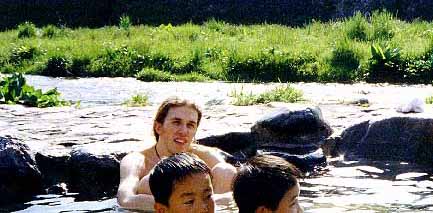
Next chapter:

 Cannabis in Japan - A vocabulary primer
Cannabis in Japan - A vocabulary primer
 See also:
See also:

 "Hempen Culture in Japan",
Hemp Library,
taima.org main index,
"Hempen Culture in Japan",
Hemp Library,
taima.org main index,

|














